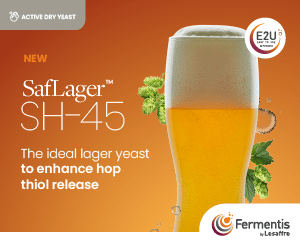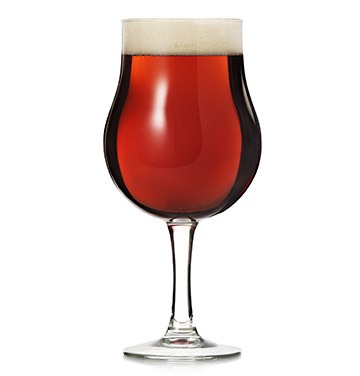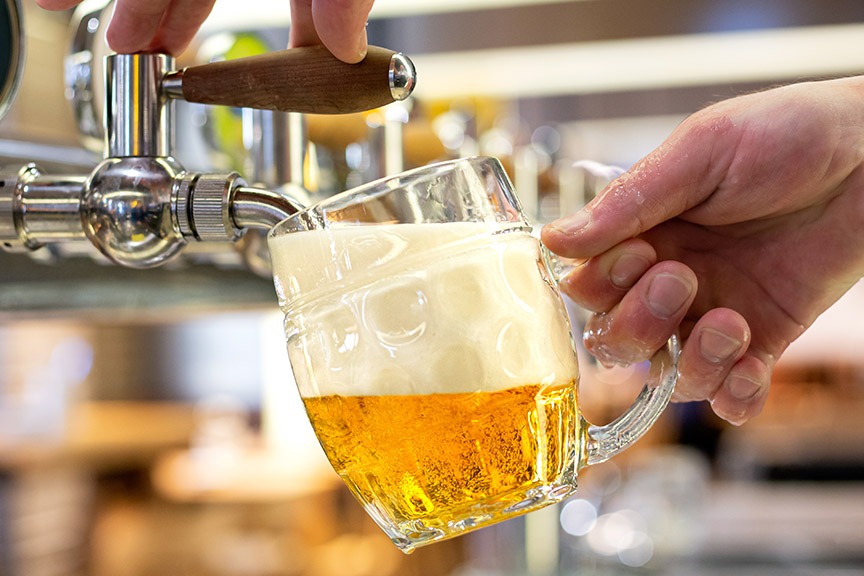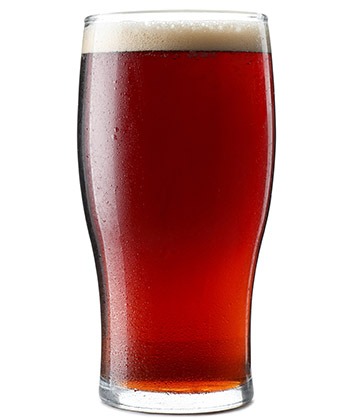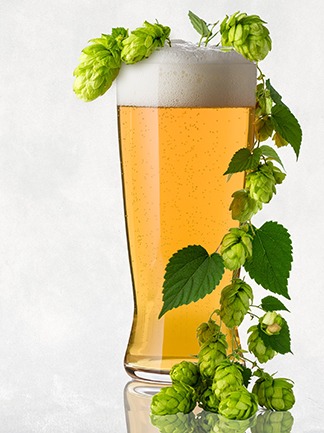German Hefeweizen
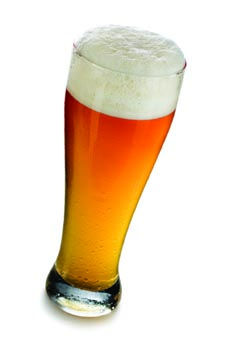 Most people seem to either love or hate German wheat beers and they usually base their opinion on early taste experiences. Those that love hefeweizen probably had the chance to try a great example with the proper level of fermentation-derived esters and phenols. Those who dislike hefeweizen likely experienced some bad examples, where the yeast character was overwhelming or completely out of balance.
Most people seem to either love or hate German wheat beers and they usually base their opinion on early taste experiences. Those that love hefeweizen probably had the chance to try a great example with the proper level of fermentation-derived esters and phenols. Those who dislike hefeweizen likely experienced some bad examples, where the yeast character was overwhelming or completely out of balance.
When I first started judging beer competitions there were two categories I dreaded, Belgian strong ales and German wheat beers. Back then craft brewers and homebrewers alike often made very poor examples, with the Belgian strong ales like sugary rocket fuel and the German wheat beers similar to banana/clove candy mixed with uncooked dough. A big part of the problem was brewers reading too much into competition style guidelines. When guidelines mention a warming alcohol note, the inexperienced brewer brews a beer that tastes like exhaust from a jumbo jet. We should all remind ourselves from time to time that the descriptions in guidelines often describe things as detected by a very sensitive judging palate, focused on detecting every last little nuance of a beer.
Hefeweizen is a traditional Bavarian wheat beer brewed with at least 50% wheat malt and yeast that produce a signature clove and banana character. The hopping rate is very low, which allows an underlying, grainy, bready flavor from the wheat and Pilsner malt to shine through. It is a light, approachable beer with a hazy appearance and has a soft texture. It has a high level of protein and suspended yeast that makes hefeweizen a cloudy, or at least a hazy, beer. While most brewers are familiar with a cloudy German hefeweizen, there is also a filtered, brilliantly clear version called kristallweizen. Hefeweizen ranges in color from pale straw to dark gold and has a large, dense, creamy white head. The aroma of a good hefeweizen includes moderate spicy clove notes and fruity banana esters. However, one of the most common mistakes in homebrewed weizen-style beers is having too much clove and banana character. Brewers might point to the BJCP style guide which says these phenolic and ester compounds can range up to “strong,” but do not think for a minute that it means a clove/banana bomb is acceptable. These fermentation compounds should never overwhelm the other characteristics of the beer. It is critical that a brewer keeps these compounds balanced with the overall harmony of the beer, especially the malts. For new brewers, it might be better to think of the word “strong” as meaning “clearly evident.” You should be able to smell and taste a bready, grainy character along with the clove and banana. The balance between bittering and sweetness is usually even, though some examples can have an initial sweetness up front. While I do not think an obvious acidic or tart character is indicative of great hefeweizen, I do think a light citrusy character along with proper attenuation, pH, and hop/malt balance keeps this style refreshing and balanced.
When I was a new brewer, I brewed less-than-perfect hefeweizen and I played around with all sorts of strange malt combinations. It was my dear friend, Harold Gulbransen, who convinced me that simple was better. Use at least 50% wheat malt and the rest high quality continental Pilsner malt. If you wish, a small portion of head or body building dextrin malt is also acceptable. A common hefeweizen recipe would be 50 to 70% wheat malt, 30 to 50% Pilsner malt, and 0 to 5% light colored dextrin malt. That is all you need to brew a great hefeweizen. While you might consider adding some other malts to develop bready flavors or body, I learned it is much better to focus on your process. Keep in mind brewers craft the world’s best examples from this simple recipe.
Historically, most weizen-type beers would have been decoction mashed and Gulbransen is a staunch proponent of decoction for hefeweizen. “I like decoction because it lends a full, toasty maltiness that seems absent in a single infusion mash,” Gulbransen said. “Since today’s malts are so highly modified, I prefer to start my mash at 130 to 134 °F (54 to 57 °C) to avoid a protein rest. I then pull a single decoction, boiling it for 10 to 15 minutes, before I return it to the mash and raise the entire mash for a rest at 152 °F (67 °C).” I can attest to the quality of Gulbransen’s hefeweizen; his methods do work well.
Matthew Brynildson of Firestone Walker Brewing Company in Paso Robles, California has won many awards. Recently they won an amazing six medals at the 2010 World Beer Cup. They also won their third Champion Brewery award and took a gold medal with their hefeweizen. I asked Brynildson what he felt was key to making a world-class hefeweizen. Brynildson favors a step mash and considers a ferulic acid rest very important to the proper development of fermentation flavors for this style.
“Mashing at 110 °F (43 °C) aids in the hydrolysis of ferulic acid. The yeast use ferulic acid to produce 4-vinyl guaiacol, which is the phenolic (clove-like) flavor compound that is so important in this style,” he said.
If you do not have the ability to perform a decoction or a step mash, or are too lazy like me, then do not worry. Yes, a decoction mash will enhance the malt profile and a step mash will ensure enough clove flavors are present, but most important is using the best quality malt or malt extract you can find and fermenting the beer properly. You should be able to make a fantastic example of the style just using a single infusion mash. Once you have mastered that, then you can try the mash techniques of masters like Gulbransen and Brynildson.
For a single infusion mash, target a temperature range of 150 to 154 °F (66 – 68 °C). If you are making a lower gravity beer, use the higher end of this temperature range to leave the beer with a bit more fullness. If you are making a bigger beer, use the lower end of the range to avoid too full of a character, which can limit drinkability. Keep in mind wheat malt is huskless, so if your equipment is prone to stuck mashes, you can add a volume of rice hulls equal to the volume of wheat malt.
This is an easy style for extract brewers. Select a fresh, well-made extract with at least 50% wheat malt and the rest Pilsner malt. Most wheat extracts are approximately half wheat and half Pilsner or two-row malt.
Try to use German hops for German beers, such as Hallertau, Spalt, Tettnang, Perle, Magnum or Tradition. If you cannot source one of those, Liberty or Mount Hood can be an acceptable substitute. Balance the beer with enough hop bitterness to balance, but not enough to overwhelm the malt sweetness of the beer. The balance should be even, or maybe slightly sweet, but not more. Brynildson also recommends keeping the hopping levels low. He targets less than 10 IBUs in their weiss, which is a bitterness-to-starting gravity ratio (IBU divided by OG) of 0.2. The bulk of the hopping should be as a bittering addition at 60 minutes. Limit late hop additions, if used at all, to a small addition of noble hops near the end of the boil.
My favorite yeast strains for all weizen-type beers are White Labs WLP300 Hefeweizen Ale and Wyeast 3068 Weihenstephan Weizen. You can try other weizen-type yeasts, and might prefer one strain to the another, so feel free to experiment.
One vital piece of information I lacked when I first started brewing hefeweizen was proper fermentation temperature. I tried all sorts of temperatures with mediocre results before Gulbransen told me to ferment at 62 °F (17 °C). I was skeptical, but the results were spectacular. That temperature will work well in most cases, but keep in mind many other fermentation factors play a role in determining the final flavor profile of the beer. For example, increasing the ratio of glucose to maltose in the wort increases the production of isoamyl acetate (banana flavor), but so does adjusting the pitching rate or other factors that affect growth. Keep in mind that while yeast strain and temperature play a large role in fermentation character, growth rate, pitching rate and other factors all have a significant impact on the types and amounts of esters yeast produce.
While some brewers like to pitch a reduced cell count to increase fermentation characteristics, I am not a big fan of this technique for homebrewing as it can also result in under-attenuation when temperature, oxygen or yeast viability is not carefully controlled. An under-attenuated hefeweizen is far worse than one with a slightly less than ideal ester profile. Brynildson says that he, “found it is best to utilize freshly propagated yeast and to avoid over pitching the wort.” So do not over pitch and do not under pitch. You want a certain amount of growth to develop the ideal flavor profile. Do not be afraid to experiment with different pitching rates and oxygen levels, but only experiment with one parameter at a time, until you get the right fermentation character for your brewery.
One last piece of advice is to consume hefeweizen fresh. What many people think is “malt character” in imported examples is often just a form of staling. When your beer lacks that character, be happy and drink lots.
Harold-is-Weizen, All-Grain
(5 gallons/19 L, all-grain)
OG = 1.049 (12 °P) FG = 1.012 (3 °P) IBU = 13 SRM = 3 ABV = 4.8%
Ingredients
4.85 lb. (2.2 kg) Great Western wheat malt (2 °L) (or similar)
4.85 lb. (2.2 kg) Durst Pilsner malt (2 °L) (or similar)
2.68 AAU Hallertau pellet hops, (0.67 oz./19 g of 4% alpha acids) (60 min.)
Wyeast 3068 (Weihenstephan Weizen) or White Labs WLP300 (Hefeweizen Ale) yeast
Step by Step
Mill the grains and dough-in targeting a mash of around 1.5 quarts of water to 1 pound of grain (a liquor-to-grist ratio of about 3:1 by weight). If you have the ability to do a step mash, start with a rest at 110 °F (43 °C) for 20 minutes and then raise to a temperature of 152 °F (67 °C) until conversion is complete. Otherwise, do a single infusion mash at 151 °F (66 °C) until enzymatic conversion is complete. Infuse the mash with near boiling water while stirring or with a recirculating mash system raise the temperature to mash out at 168 °F (76 °C). Sparge slowly with 170 °F (77 °C) water, collecting wort until the pre-boil kettle volume is around 6.5 gallons (25 L) and the gravity is 1.038 (9.4 °P).
The total wort boil time is 90 minutes, which helps reduce the S-Methyl Methiomine (SMM) present in the lightly kilned pilsner malt and results in less Dimethyl sulfide (DMS) in the finished beer. Add the bittering hops with 60 minutes remaining in the boil. I skip using kettle finings in this beer, unless making a kristallweizen. Chill the wort rapidly to 62 °F (17 °C), let the break material settle, rack to the fermenter, pitch the yeast and aerate thoroughly. The proper pitch rate is 1.7 packages of fresh liquid yeast or 1 package of liquid yeast in a 1.3-liter starter.
Ferment at 62 °F (17 °C) until the beer attenuates fully. With healthy yeast, fermentation should be complete in a week, but do not rush it. The cooler than average ale fermentation temperature can extend the time it takes for complete attenuation. Rack to a keg and force carbonate or rack to a bottling bucket, add priming sugar, and bottle. Target a carbonation level of 2.5 to 3 volumes.
Harold-is-Weizen, Extract
(5 gallons/19 L, extract)
OG = 1.049 (12.1 °P) FG = 1.013 (3.2 °P) IBU = 13 SRM = 5 ABV = 4.8%
Ingredients
4.85 lb. (2.2 kg) wheat liquid malt extract (4 °L)
2.68 AAU Hallertau pellet hops, (0.67 oz./19 g of 4% alpha acids) (60 min.)
Wyeast 3068 Weihenstephan Weizen or White Labs WLP300 Hefeweizen Ale yeast
Step by Step
I have used a number of wheat extracts with good results. The type my homebrew shop carries is a private label made for them. Feel free to use whatever your shop recommends. Always choose the freshest extract that fits the beer style. If you cannot get fresh liquid malt extract, it is better to use an appropriate amount of dried malt extract (DME) instead. My hops are in pellet form and come from Hop Union.
Mix enough water with the malt extract to make a pre-boil volume of 5.9 gallons (22.3 L) and a gravity of 1.042 (10.4 °P). Stir thoroughly to help dissolve the extract and bring to a boil.
The total wort boil time is 60 minutes. Add the bittering hops with 60 minutes remaining in the boil. I skip using kettle finings in this beer, unless making a kristallweizen. Chill the wort rapidly to 62 °F (17 °C), let the break material settle, rack to the fermenter, pitch the yeast and aerate thoroughly. The proper pitch rate is 1.7 packages of fresh liquid yeast or 1 package of liquid yeast in a 1.3-liter starter.
Ferment at 62 °F (17 °C) until the beer attenuates fully. With healthy yeast, fermentation should be complete in a week, but do not rush it. The cooler than average ale fermentation temperature can extend the time it takes for complete attenuation. Rack to a keg and force carbonate or rack to a bottling bucket, add priming sugar, and bottle. Target a carbonation level of 2.5 to 3 volumes.



